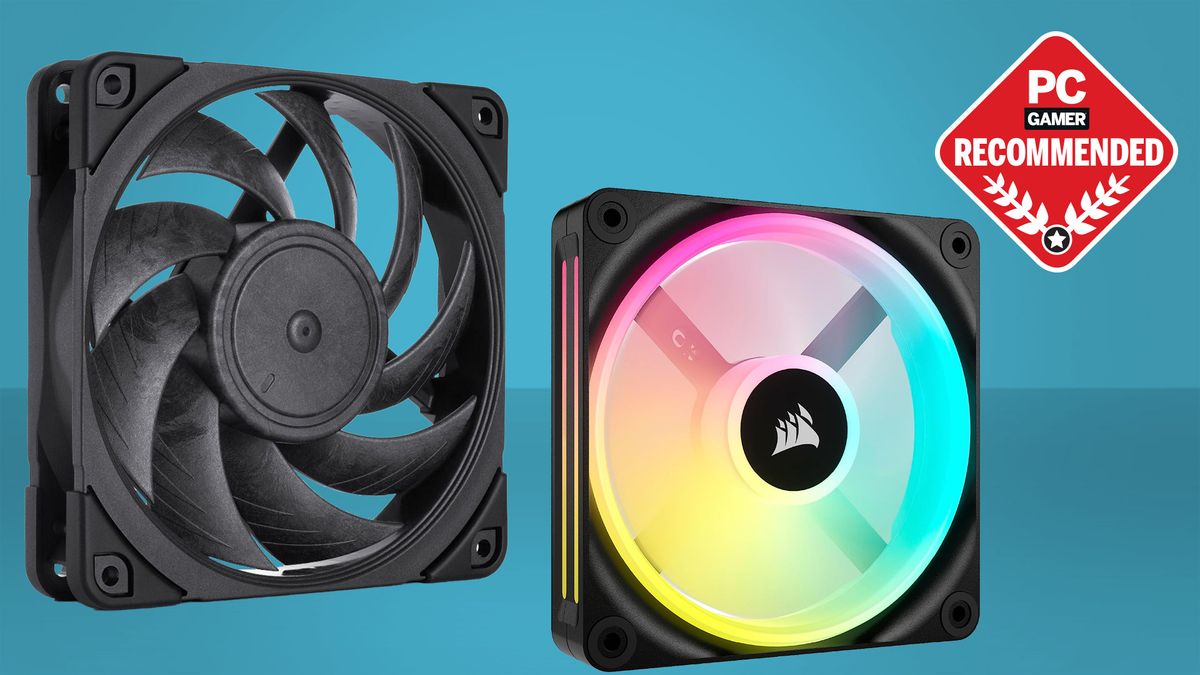9 Best Computer Fans for Efficient Cooling in 2024
Keeping your computer cool is crucial for its performance and longevity. Whether you’re a gamer pushing your system to the limits or a professional relying on your PC for demanding tasks, the right computer fan can make all the difference. With so many options on the market, finding the best one for your needs might seem daunting.
Don’t worry; we’ve got you covered. In this article, we’ll break down the 9 best computer fans that balance efficiency, noise levels, and price. You’ll find options suited for various setups, ensuring your machine runs smoothly and quietly.
1. The Best Overall Computer Fan
To kick off our list, we’ve selected the best all-around computer fan that balances performance, noise levels, and price.
Features and Specifications
Equipped with PWM (Pulse Width Modulation) for precise speed control, this fan delivers outstanding airflow at 1200 RPM. It features anti-vibration pads to reduce noise and an impressive lifespan of 40,000 hours, ensuring longevity and reliability. With a sleek design and RGB lighting, it also enhances your computer’s aesthetics.
Pros and Cons
- Versatile: Suitable for various setups, including gaming rigs and workstations
- Quiet: Operates at a low noise level, maintaining a peaceful environment
- Durable: High lifespan extends operational utility, saving future replacement costs
- Premium Price: Higher cost compared to basic models
- Installation: May require additional setup time due to PWM and RGB features
2. The Best Budget Computer Fan
Finding a computer fan that balances performance and cost can be challenging. We’ve identified the top budget option to keep your system cool without breaking the bank.
Features and Specifications
This budget-friendly fan features a 120mm size, fitting most standard setups. It operates at 1000 RPM, delivering adequate airflow to maintain optimal temperatures. The fan boasts a minimal noise level of only 25 dBA, ensuring a quiet environment. Equipped with hydraulic bearings, it promises durability and smooth operation. Despite its budget label, it includes anti-vibration mounts, reducing noise and enhancing stability.
Pros and Cons
Pros:
- Affordability makes it accessible to budget-conscious users.
- Quiet operation at 25 dBA ensures minimal noise distraction.
- Hydraulic bearings enhance longevity and performance.
- Anti-vibration mounts improve stability and noise reduction.
- Limited to basic cooling needs; may not suffice for high-performance systems.
- Lacks advanced features like PWM control and RGB lighting.
- Performance is modest compared to higher-end models.
3. The Best Quiet Computer Fan
If you need a computer fan that keeps your system cool without making noise, look no further.
Features and Specifications
This fan operates at a whisper-quiet 17 dBA, making it perfect for noise-sensitive environments. With a 120mm size and advanced blade design, it efficiently moves air at 1500 RPM. Its fluid dynamic bearing ensures a long lifespan, up to 60,000 hours, and maintains operational silence. It also includes PWM control for precise speed adjustments and anti-vibration mounts to further minimize noise.
- Pros:
- Ultra-quiet operation at 17 dBA
- Efficient airflow with 1500 RPM and advanced blade design
- Long lifespan of up to 60,000 hours
- PWM control for speed adjustments
- Anti-vibration mounts for reduced noise
- Cons:
- Higher price point than standard fans
4. The Best High-Performance Computer Fan
When you need superior cooling for intense tasks, the best high-performance computer fan delivers optimal airflow and durability. This fan is engineered for enthusiasts and professionals alike.
Features and Specifications
- High RPM: This fan operates at an impressive speed of 2000 RPM, ensuring maximum airflow.
- Advanced Bearing: Equipped with a dual ball bearing, it guarantees a lifespan of over 70,000 hours.
- PWM Control: Offers precise speed management, adapting to your system’s demands.
- High Airflow: Moves up to 90 CFM (cubic feet per minute), efficiently dissipating heat.
- Noise Level: Maintains moderate noise levels at 30 dBA, balancing performance and acoustics.
- Anti-Vibration Mounts: Reduces vibration and stabilizes fan operation, decreasing noise.
- Durability: Made with high-quality materials to withstand high-intensity usage.
- Pros:
- Optimal Cooling: Superior airflow significantly reduces temperatures during heavy loads.
- Longevity: Dual ball bearing ensures a long operational life.
- Customization: PWM control allows for tailored speed settings.
- Stability: Anti-vibration mounts enhance stability and minimize noise.
- Cons:
- Noise Level: Higher RPM results in slightly more noise compared to quieter fans.
- Price: Quality and performance come at a higher cost.
- Power Consumption: Higher speed and performance might consume more power than standard fans.
5. The Best Computer Fan for Small Spaces
When desk real estate is limited, you need a fan that’s compact but still powerful. Here’s a great option focused on small spaces.
Features and Specifications
This fan only measures 92mm, perfect for tight enclosures. It delivers a strong airflow of 37.9 CFM despite its small size. The fan utilizes a hydraulic bearing, ensuring a noiseless operation at 23 dBA. With a maximum RPM of 1800, it’s designed to fit snugly in compact builds without sacrificing airflow. PWM control allows for flexible speed adjustment, giving you full control over cooling needs.
Pros and Cons
- Size: Compact design fits easily in small cases.
- Noise Level: Operates quietly at just 23 dBA.
- Airflow: Strong performance with 37.9 CFM.
- Control: PWM control for customizable speeds.
- Cooling Capacity: Less powerful than larger models.
- Compatibility: Not suitable for larger cases.
- Durability: Shorter lifespan compared to dual ball bearing fans.
6. The Best RGB Computer Fan
Looking to add some flair to your PC setup? An RGB computer fan not only enhances cooling but also brings vibrant lighting to your rig.
Features and Specifications
An ideal RGB computer fan combines performance with eye-catching aesthetics. You’ll find specs like a maximum RPM of 1800, ensuring efficient cooling. It typically offers customizable lighting with millions of color options and various lighting modes. Anti-vibration mounts and hydraulic bearings make for quieter and smoother operation. Look for a fan that provides high airflow—often around 51 CFM—and moderate noise levels, averaging 28 dBA.
Pros and Cons
Pros:
- Boosts cooling while adding customizable lighting.
- Features anti-vibration mounts for more stability.
- Hydraulic bearings offer quieter performance.
- Can be more expensive than non-RGB models.
- May require additional software for full customization.
- Potential for higher power consumption.
This RGB fan perfectly balances cooling efficiency and stylish lighting, making your build both functional and visually appealing.
7. The Best Magnetic Levitation Computer Fan
Magnetic levitation fans offer cutting-edge technology, ensuring maximum efficiency and durability.
Features and Specifications
Magnetic levitation fans, such as the Corsair ML120, incorporate magnetic levitation bearings to minimize friction. They typically reach up to 2,000 RPM, providing exceptional airflow. Most include PWM control, allowing precise adjustments to fan speed. The fan blades are designed for optimal air pressure and low noise levels.
| Feature | Specification |
|---|---|
| Bearing Type | Magnetic Levitation |
| Maximum Speed | 2,000 RPM |
| Airflow | Up to 75 CFM |
| Noise Level | Around 37 dB(A) |
| Power Consumption | 0.22A @ 12V |
Pros and Cons
Magnetic levitation fans excel in several areas, making them a popular choice among enthusiasts.
Pros:
- Minimize friction and wear to ensure longevity.
- Deliver high airflow and pressure for better cooling.
- Maintain low noise levels, even at high speeds.
- Provide precise speed control with PWM functionality.
- Come at a higher price than standard fans.
- Require a dedicated PWM header on your motherboard.
- May need specific mounts for optimal performance.
Magnetic levitation fans combine advanced technology with superb performance, making them an excellent choice for your cooling needs.
8. The Best Computer Fan for Water Cooling Setups
When it comes to water cooling setups, you need a fan that can provide superior static pressure to push air through radiators efficiently. Let’s dive into key features and the pros and cons of the best options.
Features and Specifications
Corsair’s ML120 Pro stands out in water cooling setups. It offers magnetic levitation bearings, allowing the fan to reach up to 2,000 RPM while minimizing friction. With a static pressure rating of 4.2 mm-H2O, it excels in directing airflow through dense radiators. The design includes PWM control, providing precise fan speed adjustments for optimized performance.
Pros and Cons
Pros:
- Incredible static pressure: Ideal for radiator cooling.
- Magnetic levitation bearings: Reduced friction and noise.
- PWM control: Tailored cooling performance.
- Higher price: Premium features come at a cost.
- Specific mounting: May need custom mounts for some setups.
This fan’s advanced features and superior performance make it a go-to for water cooling enthusiasts.
9. The Most Versatile Computer Fan
When versatility is key, you need a fan that adapts to various configurations and requirements effortlessly.
Features and Specifications
This fan offers an adjustable RPM range from 600 to 2,000, letting you tailor performance to your needs. It’s equipped with PWM control for precise speed adjustments, and silica gel pads to minimize vibrations. The hybrid blade design boosts both airflow and static pressure, making this fan suitable for various applications, from case exhaust to radiator cooling. Additionally, the included RGB lighting adds flair, with customizable settings through compatible software.
Pros and Cons
- Versatile RPM range: Adjusts from silent operation to high-performance cooling.
- PWM control: Ensures precise speed management.
- Hybrid blade design: Balances airflow and static pressure.
- Minimal vibrations: Silica gel pads reduce noise.
- RGB lighting: Customizable settings for personalization.
- Price: Higher than standard fans.
- Software dependency: Requires compatible software for RGB customization.
- Installation: May need specific mounts.
Comparing Features Among the Top 9 Computer Fans
When choosing the best computer fan, it’s important to consider various features. Below, we compare performance and price to help you make an informed decision.
Performance Comparison
- RPM Range: Higher RPMs typically mean better cooling performance. The versatile fan mentioned earlier boasts an adjustable RPM range from 600 to 2,000, suitable for multiple configurations.
- PWM Control: Fans with PWM control like the high-performance and versatile models allow for automatic speed adjustments based on temperature, ensuring efficient cooling and noise reduction.
- Anti-Vibration Mounts: Important for reducing noise and extending fan life, anti-vibration mounts are a standout feature in high-performance fans.
- Hybrid Blade Design: Balancing airflow and static pressure, hybrid blade designs, as seen in the versatile fan, are essential for optimizing performance in various setups.
- Magnetic Levitation: This technology, available in some premium fans, offers precise speed control and extends the fan’s lifespan.
- Budget-Friendly Options: Compact fans, designed for small spaces, offer reliable performance without breaking the bank, making them ideal if you’re on a budget.
- Mid-Range Selections: RGB fans, with customizable lighting and decent performance metrics, fall into the mid-range price category, offering a balance between cost and features.
- High-End Fans: The versatile fan with advanced features like a wide RPM range, PWM control, hybrid blades, and RGB lighting tends to be the most expensive, reflecting its high-performance capabilities and customization options.
- Longevity vs. Cost: While magnetic levitation fans are on the pricier side, their longer lifespan and enhanced performance often justify the price.
By weighing these features against your specific needs and budget, you can find the perfect computer fan to keep your system running cool and efficiently.
Conclusion
Choosing the right computer fan is crucial for maintaining optimal performance and longevity of your system. Whether you’re into gaming, video editing, or just need a reliable cooling solution, there’s a fan out there that meets your needs. From high RPM and PWM control to customizable RGB lighting and anti-vibration mounts, the options are vast. Consider your specific requirements and budget to find the perfect balance of performance and aesthetics. By investing in a quality computer fan, you ensure your system runs smoothly, efficiently, and stays cool under pressure.






